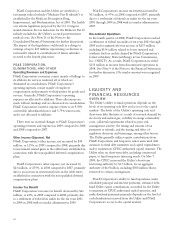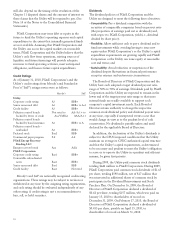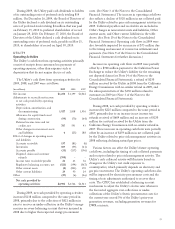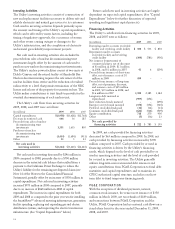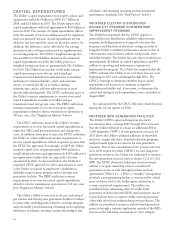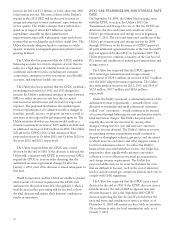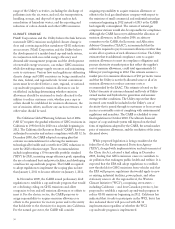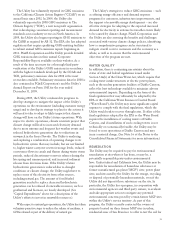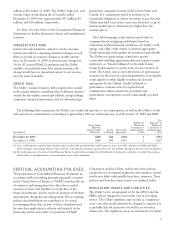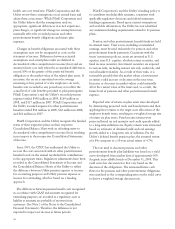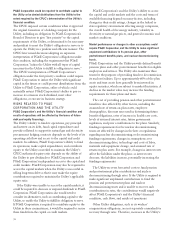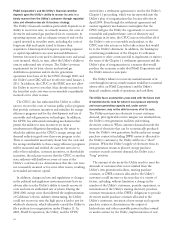PG&E 2009 Annual Report Download - page 34
Download and view the complete annual report
Please find page 34 of the 2009 PG&E annual report below. You can navigate through the pages in the report by either clicking on the pages listed below, or by using the keyword search tool below to find specific information within the annual report.range of the Utility’s activities, including the discharge of
pollutants into the air, water, and soil; the transportation,
handling, storage, and disposal of spent nuclear fuel;
remediation of hazardous wastes; and the reporting and
reduction of carbon dioxide and other GHG emissions.
CLIMATE CHANGE
PG&E Corporation and the Utility believe the link between
man-made GHG emissions and global climate change is
clear and convincing and that mandatory GHG reductions
are necessary. PG&E Corporation and the Utility believe
the development of a market-based cap-and-trade system,
in conjunction with successful energy efficiency and
demand-side management programs and the development
of renewable energy resources, can reduce GHG emissions
while diversifying energy supply resources and minimizing
costs to customers. Various laws and regulations addressing
climate change and GHG emissions are being considered at
the state, federal, and regional levels. Several contentious
issues must be resolved before a state, regional, or national
cap-and-trade program for emission allowances can be
established, including determining whether emission
allowances should be auctioned or freely allocated to the
utilities to reduce customer costs, whether price caps or
collars should be established for emission allowances, the
use of emission offsets, and how any auction revenues or
other value should be used.
The California Global Warming Solutions Act of 2006
(“AB 32”) requires the gradual reduction of GHG emissions in
California to 1990 levels by 2020 on a schedule beginning in
2012. The California Air Resources Board (“CARB”) has been
authorized to monitor and enforce compliance with AB 32. In
December 2008, the CARB adopted a scoping plan that
contains recommendations for achieving the maximum
technologically feasible and cost-effective GHG reductions to
meet the 2020 reduction target. These recommendations
include implementing a 33% renewable portfolio standard
(“RPS”) by 2020, increasing energy efficiency goals, expanding
the use of combined heat and power facilities, and developing
a multi-sector cap-and-trade program. The CARB is required
to adopt regulations to implement the scoping plan no later
than January 1, 2011 to become effective on January 1, 2012.
In November 2009, the CARB issued preliminary draft
regulations to establish a cap-and-trade program that would
set a declining ceiling on GHG emissions and allow
companies to buy and sell emission allowances or offsets to
meet it. For the electric sector, the CARB proposes to
assign responsibility to acquire emission allowances or
offsets to the generator for in-state power and to the entity
that holds title to the electricity for imports into California.
For the natural gas sector, the CARB will consider
assigning responsibility to acquire emission allowances or
offsets to the local gas distribution company with respect to
the emissions of small commercial and residential natural gas
consumers beginning in 2012 instead of 2015 as the CARB
had originally contemplated. The owners of natural gas
compressor stations would also be responsible for compliance.
Although the CARB has not yet addressed the allocation of
emission allowances, in December 2009, an advisory
committee to the CARB, the Economic and Allocation
Advisory Committee (“EAAC”), recommended that the
utilities be required to pay for emission allowances rather than
receive all or a portion of such allowances for free. The Utility
estimates that its additional compliance costs to acquire
emission allowances to meet its compliance obligations and
procure electricity at market prices that reflect the supplier’s
cost of emission allowances, could total approximately $1
billion per year beginning in 2012. This estimate assumes a
market price for emissions allowances of $30 per metric tonne
and that the Utility is not freely allocated some or all of its
emission allowances to reduce customer costs as
recommended by the EAAC. This estimate is based on the
Utility’s forecasts of customer demand and levels of Utility-
owned nuclear and hydroelectric generation and assumes
average weather conditions. The Utility expects that these
increased costs would be included in the Utility’s cost of
electricity that is passed through to customers or be recovered
in rates as reasonable costs of complying with environmental
regulations and mandates. The CARB is scheduled to issue
final regulations in October 2010. The ultimate financial
impact of a cap-and-trade system will depend on the final
form of regulations adopted by the CARB, the actual market
price of emissions allowances, and the resolution of the issues
discussed above.
While proposed legislation is being considered at the
federal level, the Environmental Protection Agency
(“EPA”), charged with implementation and enforcement of
the Clean Air Act, released a final ruling in December
2009, finding that GHG emissions cause or contribute to
air pollution that endangers public health and welfare. It is
expected that the EPA will adopt regulations to establish
new thresholds for GHG emissions from vehicles and that
the EPA will propose regulations that would apply to new
or existing industrial facilities, power plants, and other
stationary sources. At the regional level, the Western
Climate Initiative (“WCI”), comprising seven states —
including California — and four Canadian provinces, has
proposed to establish a regional cap-and-trade program to
reduce GHG emissions beginning in 2012. California has
indicated that it seeks to participate in the WCI, but it has
also indicated that it will proceed with AB 32
implementation regardless of whether the WCI
cap-and-trade program is implemented.
30


